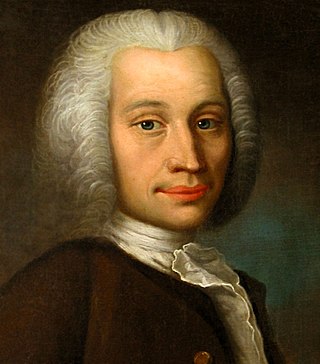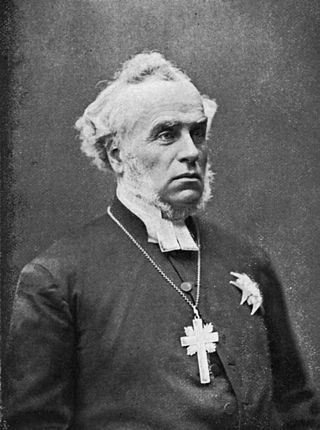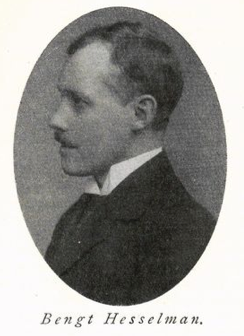This article needs additional citations for verification .(January 2021) |

Lars Roberg (4 January 1664 – 21 May 1742) was a Swedish physician and natural science researcher. He served as a professor of anatomy and medicine at Uppsala University. [1]
This article needs additional citations for verification .(January 2021) |

Lars Roberg (4 January 1664 – 21 May 1742) was a Swedish physician and natural science researcher. He served as a professor of anatomy and medicine at Uppsala University. [1]
Roberg was born in Stockholm, Sweden. He was the son of the royal apothecary Daniel Roberg. He matriculated at Uppsala University at a young age in 1675, and left for a long foreign journey in 1680 to Germany, France and England, during which he studied at the University of Wittenberg and University of Leiden. He completed his doctorate in medicine at Leiden in 1693. He became a professor of anatomy and practical medicine at Uppsala University in 1697 and retained the chair until 1740. Lars Roberg was the teacher of Carl Linnaeus and Peter Artedi. [2] [3]
In 1708, he founded a clinic for the purpose of facilitating the practical education of medical students. Nosocomium academicum at Oxenstiernska huset in Uppsala would later be merged into the Uppsala University Hospital. [4] [5]
He was one of the first to be elected to the Royal Swedish Academy of Sciences after its formation in 1739. Lars Roberg died at Uppsala in 1742. [6]

Anders Celsius was a Swedish astronomer, physicist and mathematician. He was professor of astronomy at Uppsala University from 1730 to 1744, but traveled from 1732 to 1735 visiting notable observatories in Germany, Italy and France. He founded the Uppsala Astronomical Observatory in 1741, and in 1742 proposed the Centigrade temperature scale which was later renamed Celsius in his honour.

Olof Rudbeck the Younger or Olaus Rudbeckius d.y. was a Swedish explorer, scientist, botanist, ornithologist and rector of Uppsala University.

Anders Adolph Retzius, was a Swedish professor of anatomy and a supervisor at the Karolinska Institute in Stockholm.
Juvenalorden is a student society based at Uppsala University, Sweden. Juvenalorden was founded in 1907, but traces its traditions to the society known as "The Juvenals" (Juvenalerna), which had been active in the 1830s and 1840s.

Erik Benzelius the younger was a priest, theologian, librarian, bishop of Linköping, 1731–1742 and Archbishop of Uppsala, Sweden, 1742–1743. He was a highly learned man and one of Sweden's important Enlightenment figures.

Johannes Steuchius was Archbishop of Uppsala in the Church of Sweden from 1730 to his death.

Anton Niklas Sundberg was a Lutheran clergyman, and the Church of Sweden archbishop of Uppsala 1870–1900.

Nils Gustaf Ekholm was a Swedish meteorologist who led a Swedish geophysical expedition to Spitsbergen in 1882–1883.

Isak Gustaf Clason was a Swedish architect.
Henrik Hesselman was a Swedish professor, foresters, and botanist.

Carl von Rosenstein was the Church of Sweden Bishop of Linköping from 1809 to 1819 and Archbishop of Uppsala from 1819 to 1836.

Johan Theodor Holmskiold was a Danish noble, botanist, courtier and administrator. He was noted for his scientific work with fungi and development of the Charlottenborg Botanical Garden. His career included work as director of the Danish Postal Services and the Royal Porcelain Factory.

Axel Hamberg was a Swedish mineralogist, geographer and explorer.

Fredrik Wilhelm Scholander was a Swedish architect and artist.

Israel Hwasser was a Swedish medical doctor and professor, who became a member of the Swedish Academy in 1854.

Johan Edward Bergh was a Swedish jurist and landscape painter, associated with the Düsseldorf School.

Axel Gottfrid Leonard Billing was a Swedish cleric and theologian who served as a member of the Swedish Academy, member of the Första kammaren in the Riksdag and served as Bishop of Lund from 1898 until 1925.

Bengt Ivar Hesselman (1875–1952) was a Swedish linguist and philologist, specialising in Scandinavian languages.

Ernst Axel Henrik Key was a Swedish pathologist, member of parliament, writer and rector at Karolinska Institute.

Abraham Bäck was a Swedish physician who is considered an important reformer of Swedish medical training and the organisation of Swedish medical practice.